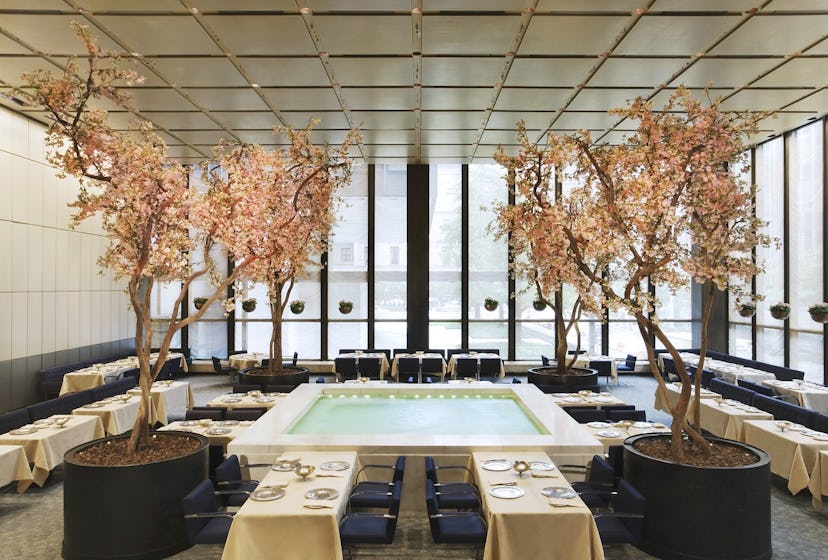R.I.P. The Four Seasons, One of America’s Great Design Icons
Before the aesthetic hallmarks of the iconic New York restaurant are auctioned off tomorrow, one writer—and loyal diner—remembers the stunner in its heyday.

Tomorrow, July 26, the hammer comes down on one of America’s greatest design icons. The Chicago auction house Wright will sell the furnishings, tableware and barware, and assorted cooking and serving pieces from The Four Seasons, the legendary restaurant designed by Philip Johnson. It opened in 1959 in the Seagram Building, the iconic Park Avenue office tower designed by the Modernist master Mies van der Rohe and completed the previous year. When it was announced in May 2015 that the restaurant was closing—its owners, Alex von Bidder and Julian Niccolini, could not agree on a new lease with the building’s owner, the real estate magnate and art collector Aby Rosen—the reaction progressed from disbelief to grief to nostalgia; for months before the restaurant served its last meal on July 16, the bar was packed. The Wright sale offers a bittersweet denouement to the story of a restaurant that survived as a cultural landmark for an improbably long time—long enough to have imprinted its memory on several generations of New Yorkers and out-of-towners alike.
The brainchild of Joseph Baum, the restaurateur who pioneered high-end themed restaurants like La Fonda del Sol, The Forum of the Twelve Caesars, and Windows on the World, the Four Seasons was the first American restaurant to introduce seasonal dishes and locally-sourced ingredients, long before anyone had heard the word “locavore.” The tall windows of the restaurant’s Grill Room, bar, and its glamorous Pool Room featured curtains of bronze chains that shimmered and moved and made the world outside seem so pleasantly hazy. (These curtains, along with Richard Lippold’s bronze sculpture above the bar, are landmarked, along with the restaurant’s architecture, and cannot be altered or removed.)
Much has been made of The Four Seasons’s status as a power-lunch mecca, but even for those who never made it into the inner sanctum of the Grill Room (the lower level only, please), it didn’t matter. Whether you were “relegated” to the Pool Room or having a more modest lunch at the bar, it was the place itself that was unique. Those soaring spaces, the sumptuous walnut paneling, the elegant dining chairs designed by Mies and custom-made by Knoll, and the elegantly simple silver-plated flatware and serving pieces by L. Garth and Ada Louise Huxtable (who would become the New York Times’s first architecture critic) were just a few of the ingredients of a glamour that is steadily vanishing from New York.
Just being in the Four Seasons made you feel that there was one place, at least, where civilization was alive and well.
This feeling kept many of us coming back even after the Four Seasons started to fray around the edges. A few years back, I visited the ladies’ room, and saw that the built-in cylindrical containers, originally designed as ashtrays, had thin layers of trash at the bottoms; they never seemed to get cleaned. On another visit, marbleized plastic soap dispensers, which looked as if they’d come from a 99-cent store, stood on the sink counter; on one of them, the pump top had snapped and hung lifeless from the bottle. The furniture needed refreshing, too; a quick look at the dining chairs during the sale preview revealed frayed and torn upholstery, and the coveted bronze-topped versions of Eero Saarinen’s Tulip side tables—there were only six made, and they will probably sell at well above their estimate of $5,000 to $7,000 each—have bases that look as if they were (and badly) painted over rather than refinished. Yes, this was a business, not a museum, but in a restaurant where a hamburger cost $38, the little things mean a lot.
Since von Bidder and Niccolini own the name, they’re taking it with them; The Four Seasons will reopen late next year down the street at 280 Park Avenue, in a space designed by the Brazilian architect Isay Weinfeld, whose work is known for its pared-down luxury. The old space will be taken over by the Major Food Group, which vaulted to fame with downtown hot spots like Parm, Carbone, and Torrisi Italian Specialties. It will attract a younger, hipper, but still moneyed crowd—which, let’s face it, the new Four Seasons will have to do, too. Before too long, almost no one will remember the drop-dead-swank space where John F. Kennedy celebrated his 45th birthday before heading over to Madison Square Garden to be serenaded by Marilyn Monroe. But if you go to the auction, maybe you can score some of the martini glasses.